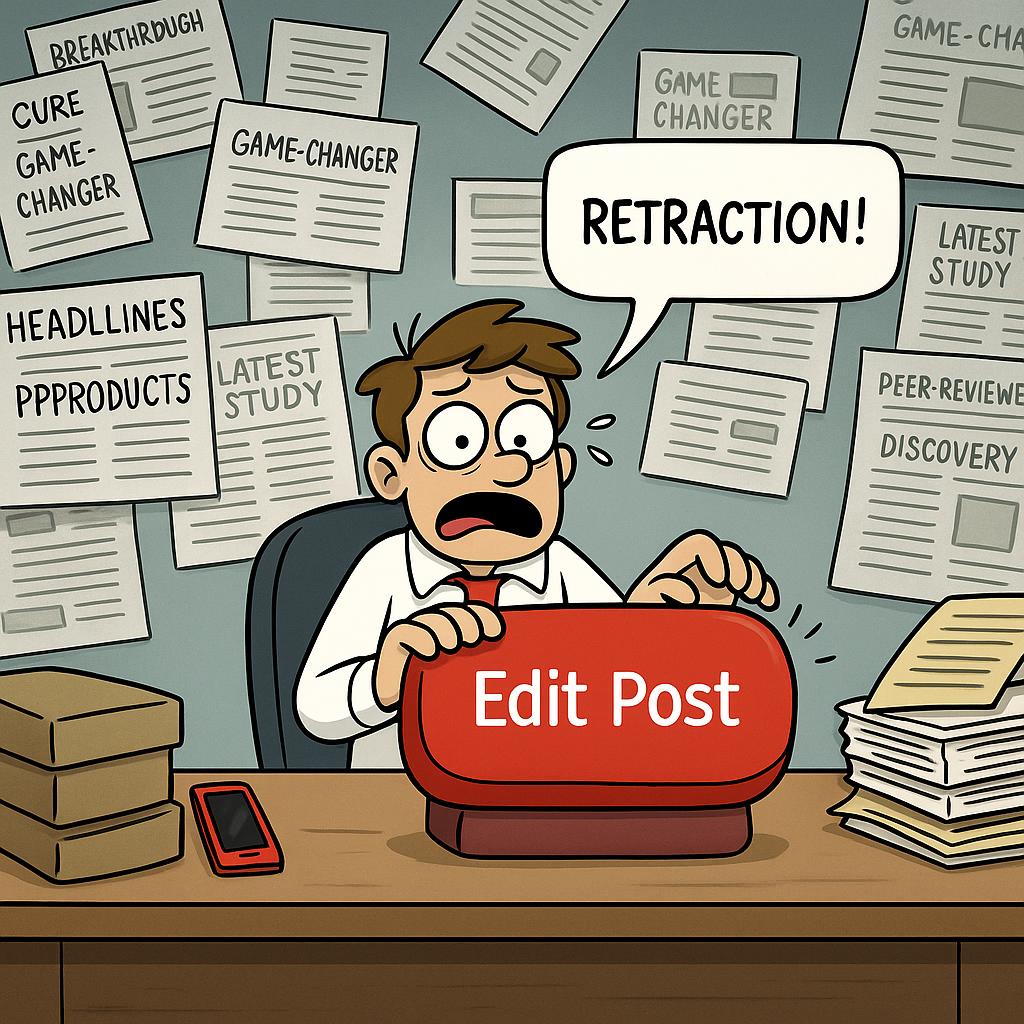Let me paint a familiar picture: You’ve just published a shiny new explainer on a “breakthrough” study. You’ve broken down the jargon, added some metaphors, maybe even dropped a Taylor Swift reference for flavor. You’re feeling good. People are liking, sharing, and learning
Then, like an unwelcome plot twist, months or years later, you find out the study’s been… retracted. Quietly. With a PDF notice and maybe a sentence or two explaining the reason.
You sink into your chair, stare at the screen, and ask the dreaded question: Did I just overhype bad science?
If this sounds familiar, congratulations, you’re a science communicator. And you’re not alone. As science communicators, we often stand on the bridge between what science says now and what it figures out later. And that’s the key: retractions aren’t science failing, they’re self-correcting. And our job isn’t to predict perfection. It’s to explain how the mess still matters.

The Emotional Whiplash of Retractions
So, what does it feel like when you’re the one who shared that story?
Let me tell you it’s awkward. Like showing up to a wedding and realizing you RSVPed to the wrong couple.
There’s the initial panic: Should I delete the post? Issue a correction? Bribe Google to de-index the whole thing.
Then come the doubts: Am I still credible? Did I mislead people? Is my science degree revoked now?
And finally, the audience questions: “Wait, wasn’t this supposed to be a cure?” or “But you said it was exciting?”
Yes, I did. But science changes. And that’s the point.
When Big Science Fails to Hold
Let’s face it, science is supposed to be wrong sometimes. Not because it’s broken, but because that’s how it works. It tests, revises, corrects, and yes, sometimes retracts. But the reality is that retractions are only the visible tip of a much bigger iceberg: reproducibility.
In 2021, the Reproducibility Project: Cancer Biology attempted to replicate findings from 53 influential preclinical studies. Only 6 out of 53 held up. That’s just 11%. And in a Nature survey of over 1,500 scientists, more than 70% reported failing to replicate someone else’s experiment, and over half couldn’t replicate their own.
Reproducibility issues don’t just impact scientists. They affect everyone who communicates, funds, or makes policy based on science. And when high-profile studies fall apart, it ripples far beyond the lab.
Let’s look at a few greatest hits in the “Oops, science did it again” playlist:
- The Alzheimer’s image scandal (2024): A 2006 paper in Nature, cited over 2,200 times, was retracted in 2024 after investigations revealed manipulated images. It had shaped the amyloid hypothesis for decades and cast long shadows on Alzheimer’s research.
- MDMA therapy studies retracted (2024): Three papers supporting MDMA-assisted therapy for PTSD were retracted due to data irregularities, ethical concerns, and underreporting of adverse effects. These studies were critical in public advocacy for psychedelic therapies.
- Hydroxychloroquine for COVID-19 (2020): Early in the pandemic, this drug was hyped as a potential miracle. A high-profile Lancet paper helped fuel the frenzy, before being retracted due to data integrity concerns. Confusion, mistrust, and political firestorms followed.
- STAP cells (2014): Researchers claimed to create stem cells by dipping blood cells in acid (yes, acid). The news exploded. Hope soared. But the study couldn’t be replicated. It was retracted after image fraud was uncovered, and tragically, one of the co-authors died by suicide, a painful reminder of the human cost of scientific failure.
These weren’t obscure findings, they were widely publicized, peer-reviewed, and media-amplified. And when they fell apart, the trust fallout wasn’t just felt in labs, it echoed throughout society.
In 2023, the number of scientific paper retractions exceeded 10,000, a record high. That figure might sound alarming, but with more than 5 million papers published annually it reflects a growing commitment to integrity and transparency in scientific publishing. It’s not that science is suddenly worse; it’s that science is getting better at catching its own mistakes.

What About the Audience?
Let’s be honest, retractions freak people out. One day it’s “Wine is good for your heart,” the next it’s “Actually, maybe not.” People throw up their hands and say, “Scientists don’t even know what they’re talking about!”
And who can blame them? If you’re not steeped in how science works, it can feel like a bait-and-switch.
But here’s the thing: science doesn’t change its mind because it’s flaky. It changes its mind because it learns. Retractions, corrections, and updated findings are signs of a field that cares enough to admit when it gets something wrong. That’s not a flaw. That’s a feature.
As communicators, it’s our job to make that mindset less intimidating and maybe even… dare I say… inspiring?
How to Future-Proof Your Science Stories
You can’t prevent retractions, but you can write stories that hold up even when the studies don’t. Here’s how:
- Center the process, not the payoff
Instead of “scientists cure cancer in mice,” try:
“Researchers test new therapy in mice, early signs are promising, but human trials far off.”
Spoiler alert: The mouse is not you.
- Humility > Hype
If your headline includes “revolutionary,” “game-changing,” or “holy grail,” maybe sleep on it. Then rewrite.
- Use watchdogs
Link to Retraction Watch, OSF, explain preprints, and mention registered reports. It shows your audience you’re not just cherry-picking headlines; you’re watching how the sausage gets made.
- Insert caveats with love
You don’t have to kill the buzz. Just temper it. Sprinkle in phrases like “early-stage,” “requires replication,” or “based on a limited sample.” It’s the journalistic version of putting on a helmet before biking through a construction zone.
Talking About Being Wrong (The Right Way)
Being transparent doesn’t mean you need to issue a dramatic mea culpa for every retracted study you shared. But it does mean:
- Updating posts or tweets if you shared outdated or now-retracted findings.
- Acknowledging the update publicly, briefly, and without shame.
- Framing retractions as science doing its job, not failing but improving.
For example:
“Update: This study has since been retracted due to data concerns. Science is self-correcting, and that’s a good thing. Stay curious!”
Trust Is Built on Candor, Not Certainty
You might think your audience wants answers, but often, they’re just looking for honest guides through the complexity. They want someone who says,
“Here’s what we know. Here’s what we don’t. And here’s what changed.”
When we normalize retractions and corrections as part of science’s natural rhythm, we invite the public to see the beauty in the process, not just the product.
Retractions aren’t signs that science is broken; they’re signs that it works hard to fix itself. And when we tell that story well, we build trust, not fear.
Final Takeaway
Science isn’t a straight road, it’s a winding trail full of detours, potholes, and the occasional “Oops, wrong turn.” But it keeps moving forward.
Not retracting when we should is more dangerous than retracting too frequently. Allowing incorrect studies to continue can lead to research failures, squander money and time, and in certain situations, result in patient injury or unsuccessful clinical trials. Even though they are painful, retractions are frequently required course corrections.
As communicators, our role isn’t just to report results, it’s to narrate the mess, the revisions, and the resilience. So yes, science might do it again.
But so will we.
We’ll update, reframe, and keep the conversation going.
Because that’s what good science and good storytelling look like.



Leave a Reply